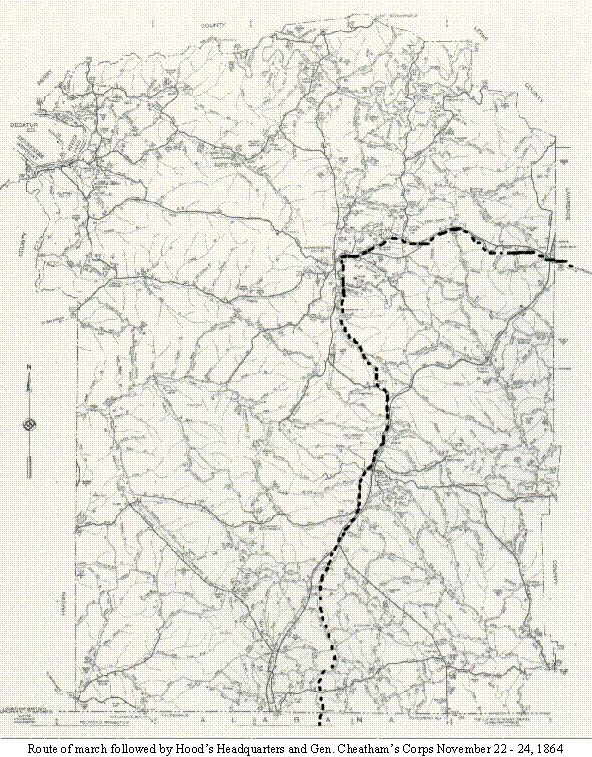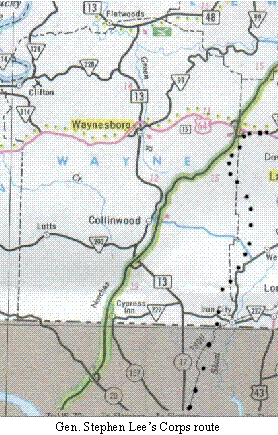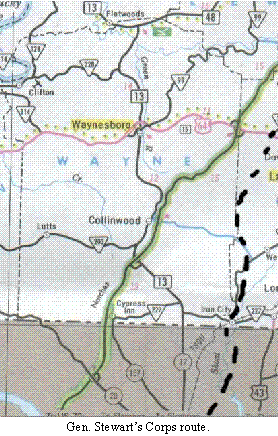Written and submitted by Edgar D. BYLER, III
[Editor’s Note: This paper was presented to the Col. Jacob BIFFLE Camp of the Sons of Confederate Veterans, Waynesboro, Tennessee]
Confederate States of America President Jefferson Davis in July of 1864, appointed Gen. John Bell Hood of Texas as commander of the Army and Department of Tennessee. Hood’s orders and general plan of action were to stop US Gen. Sherman from taking Atlanta, Georgia. However, when Atlanta fell to Sherman’s forces on 2 September 1864, Hood was forced to reconsider his strategy.
Between the 2nd of September and the second week in October, 1864, Hood attacked Sherman’s positions wherever and whenever possible. Hood did succeed in destroying the railroad between Chattanooga, Tennessee and Atlanta, but his original intention of drawing Sherman out of Atlanta failed. Sherman cabled Gen. Thomas in Nashville that he was cutting loose and was on his way to Savannah, Georgia.
Hood now found himself in the unenviable position of attempting to shadow Sherman, trying to bring him into a pitched battle with of hope of defeating him, or Hood could strike what he thought would be a death blow to the Union by invading Tennessee. After conferring with Gen. Beauregard and President Davis, the decision was made to invade Tennessee. The Confederacy hoped that such an invasion would force Sherman to return to Tennessee to defend the strategic supply points of Nashville and Paducah, Kentucky.
Between October 9th and the 30th, Hood’s army, composed of three corps: Cheatham, Lee and Stewart, began a long, recuperative retreat into Alabama. The men who had been pushed and wearied by the assault on Sherman’s troops needed to be re-outfitted and re-armed. This was accomplished as well as was feasible at various points in northeastern Alabama.
Hood first attempted to cross the Tennessee River at Decatur, Alabama. But was unable to cross due to high water and the earlier destruction of the railroad bridge. He then ordered the army to proceed to Tuscumbia, where he arrived on the 30th of October.
Hood’s army of the Tennessee was strung out in camps between Tuscumbia, South Florence, Leighton and Bainbridge. Attempts were made to cross the Tennessee River by pontoon at Bainbridge, located above the shoals, but the pontoons were cut by Federal forces.
On the 31st of October, Gen. Stephen Lee’s forces began crossing the Tennessee River from South Florence. They ran into Federal troops under the command of Gen. Hatch and following a short skirmish, Hatch retreated toward Waynesboro, Tennessee. The Confederate forces under Lee marched into Florence, Alabama to the jubilant celebration of its inhabitants.
Between the 1st of November and the 20th, Hood experienced one delay after another. Gen. Forrest did not arrive in Florence until the 14th of November having been opposite Johnsonville, Tennessee before being ordered to join Hood at Florence. While Lee’s corps had successfully crossed the river, Cheatham and Stewart’s corps were still unable to cross due to high water and flood damage to the pontoon bridge. Cheatham finally crossed the river on the 12th and 13th, while Stewart was unable to cross until the 20th.
While Hood was waiting for Cheatham and Stewart’s corps to make it across the river, Forrest had arrived and was placed in command of all the cavalry units. Forrest immediately set out toward Lawrenceburg, Tennessee, harassing the Federal troops under Gen. Hatch at every turn. Hatch finally struck back at Forrest’s command on the 19th of November in a battle on Butler Creek in Wayne County, Tennessee. The battle proved inconclusive and Hatch withdrew toward Lawrenceburg with Forrest in hot pursuit.
On the 15th of November, Col. Jacob Biffle was apparently raiding from Ashland, Wayne County, Tennessee to Linden, in Perry County and Clifton in Wayne County. It was in Clifton that Biffle was joined by more of Forrest’s command who had crossed the river from west Tennessee. On the 16thof November, Biffle was camped on Indian Creek, Wayne County, Tennessee (near his home at Biffle Spring) and probably joined up with Col. Rucker of Forrest’s command who on that date was occupying Waynesboro, Tennessee.
The records do not indicate where Biffle and Rucker were between the 16th and the 18th of November. They had probably moved out toward Lawrenceburg, Tennessee to join with Forrest’s main force. We know that they were not in Waynesboro, Tennessee on the 18th because on that date, Col. Horace Capron (US) of the 6th Division, 1st Brigade of Wilson’s Cavalry, had occupied the town with his force composed of men from the 14th and 16th Illinois Cavalry, the 5th Indiana and the 8th Michigan.
Capron did not occupy Waynesboro without a fight. He reported to Gen. Wilson and Gen. Schofield that he “occupied Waynesboro this evening [18th Nov] with the loss of 1 killed, 1 mortally wounded, 1 severely wounded, and that he had captured two scouts from Forrest’s command.” He stated that citizen intelligence reported Hood’s army was at Florence, Alabama and that Forrest was in the area around Lawrenceburg. Capron would remain in Waynesboro until the 22nd when he retreated to Mt. Pleasant and joined Gen. Hatch.
Finally, on the 20th of November, Hood was ready to begin his march. Stewart had finally crossed the river and had gone into camp six miles north of Florence on the old military road, camping at Wilson’s crossroads [now known as St. Florian]. Lee was about ten miles north of Florence on the Chisholm Road, while Cheatham and the Headquarters were just north of Florence on the old Waynesboro-Florence road [present day Cloverdale road]
 From this point until the army was united south of Mt. Pleasant, Tennessee it was spread out over a large area from Middle Cypress Creek on the west to the east of Shoals Creek. Hood’s plan was to have Cheatham’s corps and the Headquarters move north on the Waynesboro-Florence Road to Waynesboro and then on the old Columbia Central Turnpike to Mt. Pleasant. Lee would take the Chisholm Road north, moving toward West Point, Tennessee, then turn west onto the old Natchez Trace and then to the Columbia Central Turnpike. Stewart’s route remains somewhat of a mystery. He originally started out on the Military Road, but appears to have turned west near Pruitt’s Mill (Pruitton, south of Iron City, Tennessee) and followed behind Lee.
From this point until the army was united south of Mt. Pleasant, Tennessee it was spread out over a large area from Middle Cypress Creek on the west to the east of Shoals Creek. Hood’s plan was to have Cheatham’s corps and the Headquarters move north on the Waynesboro-Florence Road to Waynesboro and then on the old Columbia Central Turnpike to Mt. Pleasant. Lee would take the Chisholm Road north, moving toward West Point, Tennessee, then turn west onto the old Natchez Trace and then to the Columbia Central Turnpike. Stewart’s route remains somewhat of a mystery. He originally started out on the Military Road, but appears to have turned west near Pruitt’s Mill (Pruitton, south of Iron City, Tennessee) and followed behind Lee.
For all the soldiers marching north from Florence, Alabama, this was a time of celebration as well as despair — celebration because they were back in Tennessee which was home to many of them; despair because of the weather and their inadequate equipage and rations. When they left Florence, it was raining; but this quickly changed to snow and ice. The weather turned much colder and troops in Lee’s corps reported seeing icicles two feet long on Butler Creek. Add to this the fact that the roads were normally impassable in such weather, but were now a muddy morass because of the movement of the artillery pieces and baggage trains, it is a wonder that the troops made such good time. Often traveling 13 – 16 miles per day.
 On the 21st of November, Hood’s headquarters were at Mr. Westmoreland’s house just west of the Cloverdale Road, near present day Pisgah Methodist Church. Cheatham was camped at Rawhide (Cloverdale). Lee had crossed into Tennessee near the old Van Leer furnace on Butler Creek with Stewart somewhere between Wilson’s Crossroads and Pruitton.
On the 21st of November, Hood’s headquarters were at Mr. Westmoreland’s house just west of the Cloverdale Road, near present day Pisgah Methodist Church. Cheatham was camped at Rawhide (Cloverdale). Lee had crossed into Tennessee near the old Van Leer furnace on Butler Creek with Stewart somewhere between Wilson’s Crossroads and Pruitton.
On the 22nd of November Cheatham had marched 18 miles north on the Waynesboro-Florence Road and was camped about 15 miles south of Waynesboro. The headquarters was in a deserted house about 14 miles south of Waynesboro (near the present intersection of the Natchez Trace Parkway and Tennessee Highway 13, south of Collinwood). Lee’s corps was camped between Wayland Springs and West Point; and Forrest was engaged in the Battle of Lawrenceburg with Gen. Hatch.
It is important to point out here that Gen. Hatch had been ordered by Gen. Thomas in Nashville, to hinder the advance of Hood’s forces as much as possible, but was not to fully engage them in battle. This was to allow Thomas time to get reinforcements from Paducah, Kentucky into Nashville to strengthen his force. This was not a surprise raid on Hood’s part and Thomas well knew the importance of Hood’s force of 36,000+ men advancing toward him. Thomas’ problem was that he didn’t know exactly where Hood was going to strike.
Cheatham left camp at the intersection of the Waynesboro-Florence Road and the Old Nashville Road (Natchez Trace) on the 23rd and arrived in Waynesboro by 4:00 P.M. It is believed that his corps and the Headquarters group followed the Trace to the area of McCalls passing through what is today Collinwood, then either turned down Chalk Creek or followed the old Green River Road.
They found Waynesboro deserted. All the townspeople had fled to the nearby countryside. Cheatham didn’t stop in Waynesboro, but continued on the old Columbia Central Turnpike towards Lawrenceburg. He went into camp that evening at Wayne Furnace. Lee and Stewart were still bogged down in western Lawrence County while Forrest had proceed up the Military Road to near Summertown.
On the 24th, Cheatham, along with Hood and his headquarters, left Wayne Furnace and marched 14 miles to Mrs. Chambers house on the old Columbia Central Turnpike (just north of Ovilla). Lee had crossed over into Wayne County, probably from Fish Trap Creek and turned north onto the Pinhook Road which left the Waynesboro-Lawrenceburg Road just above where Zion Baptist Church is today and intersected the Turnpike south of Ovllla. Stewart continued north up Chisum Creek, joining the Turnpike near Deerfield.
 By the 25th, Hood’s headquarters was at Mt. Pleasant; Cheatham was south of Mt. Pleasant; Lee was on the Columbia Pike north of Mt. Pleasant, Stewart was at Henryville and Forrest was south of Columbia. By the 26th they were all at Columbia, Stewart’s corps bringing up the rear.
By the 25th, Hood’s headquarters was at Mt. Pleasant; Cheatham was south of Mt. Pleasant; Lee was on the Columbia Pike north of Mt. Pleasant, Stewart was at Henryville and Forrest was south of Columbia. By the 26th they were all at Columbia, Stewart’s corps bringing up the rear.
What followed was the Battle of Franklin and the Battle of Nashville where all Hood’s plans were dashed. Hood was a defeated man and submitted his resignation, the army was placed under the immediate command of Gen. Richard Taylor, later joining Gen. Joe Johnston for the denouement of the war.
One footnote concerning Wayne County following the battle of Nashville. The 30,000+ Federal troops who had been sent in pursuit of Gen. Hood’s retreating forces, were turned aside at Pulaski, Tennessee and made a quick march to Clifton, Tennessee where they were loaded onto transports and sent to Paducah, thence by train to Virginia for the closing episodes of the war.
Thus in the closing days of the war, Wayne County, Tennessee was to experience the trauma of two large armies passing through its territory. Everything that was not tied down or hidden was confiscated by first the Confederate troops, then the Union troops. The residents were left destitute.
